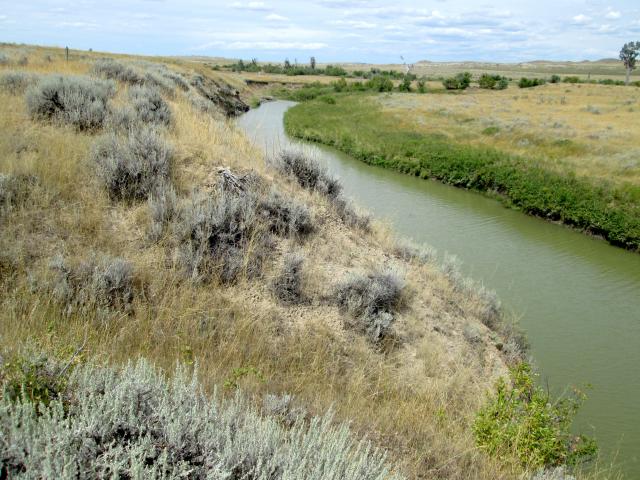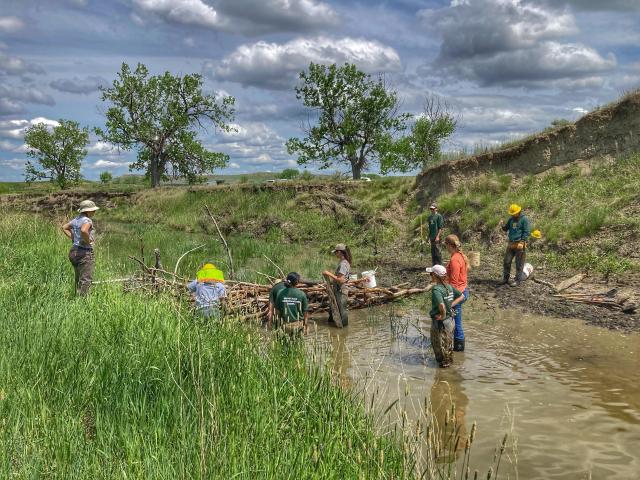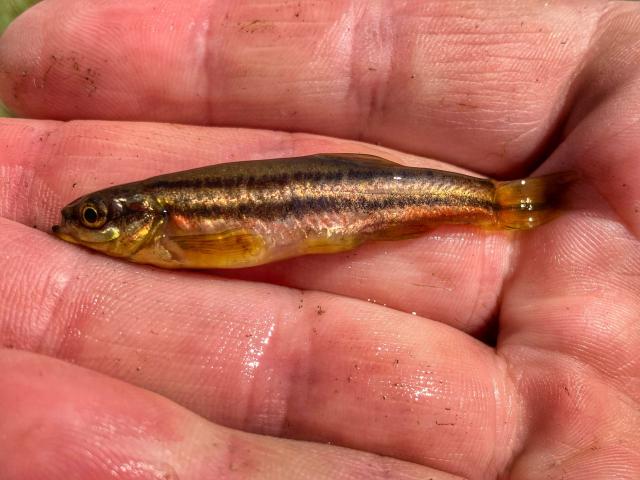You are viewing ARCHIVED content published online before January 20, 2025. Please note that this content is NOT UPDATED, and links may not work. Additionally, any previously issued diversity, equity, inclusion or gender-related guidance on this webpage should be considered rescinded. For current information, visit https://www.blm.gov/blog.
Restoring Box Elder Creek: A Journey Through Time and Land
Brenda Brady ranches in central Montana on the land that has been in her family for three generations. Her sister, Laura Nowlin, and her parents live on the same property which supports two separate cattle operations–one managed by each of the sisters. Box Elder Creek flows through the property and right past the place where Brenda and Laura’s parents live. The family shares a strong connection to the creek. “My parents house looks out right over the creek, we watch and really enjoy the birds, and the deer, and the smaller critters,” said Brady.

Over the years, due to homesteading practices such as heavy tilling, historic overgrazing, and the removal of beaver; Box Elder Creek has become degraded. Brady, Nowlin, and multiple partners are now on a mission to restore the creek to better health.
Drawn by the Water
The water in Box Elder Creek drew early homesteaders to settle this part of central Montana. The creek sits in the middle of sage grouse habitat and a migratory corridor for large game such as mule deer, elk, and antelope. As one of the main stream drainages in Petroleum County, Box Elder Creek has been used in the past, and still today, by many agriculturalists for irrigation and livestock watering. The Bureau of Land Management (BLM) manages land that is interspersed with the private ranches in the area and the agency leases some of this land for private grazing. In the middle of the last century, Box Elder Creek flowed through land leased and managed by a communal group of ranchers, including Brady and Nowlin’s grandfather. Box Elder Creek, and small reservoirs were the only sources of water on the allotment. Because of this, the vegetation along the creek was overgrazed.
When Brady’s parents secured the Box Elder Creek allotment in the 1990s, they worked with BLM to break that land up into several pastures, two of which included the creek. At that point, they implemented a rest rotation grazing system where only one of the creek pastures was grazed each year, and only in the late fall when the plants were dormant. This grazing approach gave the riparian pastures time to recover and take advantage of ideal growing conditions during the spring and summer months.
Revitalizing Box Elder Creek
Rotational grazing is still practiced on the Box Elder Creek pastures, and as a result, positive changes have been observed, including new cottonwood growth along the stream’s banks. Brady and Nowlin have also returned the dryland farming of the ranch to native grasses. The sisters continue to look for ways to improve the health of the ranch and their grazing practices. “That has been a big part of our grazing management plan for as long as I can remember,” said Brady, “taking care of the stream.”
Although grazing practices have increased the growth of trees and other riparian vegetation over the last couple of decades, Brady knows the creek still has room to improve. Through time, the creek has become deeply cut into the ground, and the waters now rush through the channel quickly in the spring when the snow melts. Based on elevation modeling and now abandoned side channels found in historic aerial imagery, the active floodplain area historically expanded across approximately 60% of the valley bottom. Currently, the active floodplain consists of only about 15% of the valley bottom. Non-riparian plants such as sagebrush grow right up to the stream bed in places, indicating that the soils are dry and not able to support plants that require more moisture. “We have a bird’s eye view because of some buttes up above the creek. We can look out and see the pattern of thick sagebrush close to the creek. That was recognized fifty years ago, and we’ve started making improvements, which began with my grandpa drilling a well and developing water infrastructure so we are no longer dependent on the creek for stock watering,” said Brady.
Beavers used to inhabit the area as well, but the loss of woody materials and water makes it difficult for them to return. While Box Elder is now considered an intermittent stream, it may have flowed year-round before homesteading and historical livestock use.

Brady has been teaming up with a group of partners, including the BLM, World Wildlife Fund, Montana Conservation Corps (MCC), Montana Fish, Wildlife & Parks (FWP), Winnet Aces, and Anabranch Solutions to increase the health of the creek by utilizing low-tech, process-based restoration techniques, which are meant to initially mimic, quickly promote, and eventually sustain natural stream processes. These structures mimic the functions of natural beaver dams and log jams and are used to slow and spread the flow of water to help the stream heal. In the right places they can create the conditions beavers need to return to historic habitat. In 2023, MCC crews visited Box Elder Creek, and completed a restoration project that led to beavers moving into the creek.
This fall, thanks in part to funding from the Bipartisan Infrastructure Law, partners are returning once again to restore additional stretches of Box Elder Creek with a focus on the BLM managed portions of the system. Woody materials for the structures will be collected from a nearby fuel reduction project, and Anabranch Solutions, a small riverscape restoration business, will lead the implementation.
“The Box Elder Creek project is taking place on private land as well as land managed by the state of Montana and the Bureau of Land Management. When combined, we have the potential to restore up to 23 miles of continuous stream in a major system in the area,” said Bonny Richard, hydrologist for the BLM’s Lewistown Field Office. The goals of the project are to raise the water table, encourage a more continuous flow, increase fish habitat, and create a safe environment for beavers that are moving through, in hopes that they will be tempted to expand their presence in Box Elder Creek.

The Revival of Prairie Fish
Clint Smith, fisheries biologist for FWP, was first introduced to low-tech restoration in 2019 when professors from Utah State University hosted a workshop in Lewistown, Montana. After the workshop, Smith sat down at his computer and looked at aerial imagery of central Montana. Box Elder Creek immediately popped up as a prime candidate for this type of restoration due to its scale, and its history as a beaver inhabited creek. Richard shared an interest in the restoration potential of Box Elder Creek.
Smith is now using the restoration work to study how prairie fish respond to the restoration techniques used on Box Elder. Much of the research to date has occurred in areas that support cold water species such as trout and salmon, and much less research has been done on prairie fish. BLM and FWP want to increase the understanding of impacts and benefits of these types of interventions in prairie streams.
Smith has identified several monitoring sites within the restoration area where he plans to monitor small bodied fish to see if they are able to move upstream through the structures designed to mimic beaver dams. He is also curious to know if a more abundant and diverse fishery can be supported by keeping water in the stream for a longer amount of time.
“In other perennial or less degraded streams in the area, we have seen goldeyes, channel catfish, river carpsuckers, spiny softshell turtles, and other nongame species. There is hope that if we keep [the Box Elder] system connected and flowing, these species that were here historically will be able to recolonize and reestablish in the drainage,” said Smith.

One of those native fish species is the Northern Redbelly x Finescale Dace hybrid, a small-bodied state species of concern with a unique life history in Montana as the species reproduces as all female clones. Higher up in the Box Elder Creek drainage, a correlation between beaver dams and the presence of dace has been noted, and Smith is interested in discovering if this hybrid dace may return to the Box Elder Creek drainage over time.
Part of revitalizing the drainage involves increasing the length of time the stream flows and increasing groundwater, but that isn’t the only aspect of a healthy system. Prior to European settlement, streams were often multi-threaded and meandering. Beaver dams, log jams, and deciduous trees and shrubs would slow the flow of water and cause new side channels to form. The streams were able to wander around their wide floodplains without constraint.
While the restoration project aims to further improve the health of the creek, the project is only possible as a result of the hard work that Brady and Nowlin, and their parents and grandparents before them, have already put into stewarding their land by improving the vegetation diversity and woody species along the channel.
“The land management side of this project is critical. We are already seeing the system move towards recovery on its own because of the way the landscape is being managed, and that started more than twenty years ago. Because the landowners are on board and doing really great work already, the project has massive potential to return the area to a functioning ecosystem,” said Smith.
About the Author
Rose Vejvoda is a graduate student at Northern Arizona University, where she is a candidate for a Professional Master of Science in Climate Science and Solutions, and a graduate certificate in Greenhouse Gas Accounting. Rose received her undergraduate degree from Montana State University where she studied English Writing, and Sustainability Studies. She has a passion for using effective storytelling to build relationships, uplift local communities, and help people feel connected to the natural world. Rose wrote this story while she was a Freshwater Ecosystems Intern at Natural Resources Defense Council in partnership with BLM.
Rose Vejvoda, Intern
Related Stories
- Connecting Utah students to public lands careers
- Worland Field Office cleans up multiple illegal dumpsites
- Veteran fuels module in Rapid City, SD sets a standard for community assistance
- Coeur d’Alene District and Nez Perce Tribe Strengthen Community Through Partnership
- Hi-Line field offices vie for “Coldest Place in America”
Office
5001 Southgate Drive
Billings, MT 59101
United States
